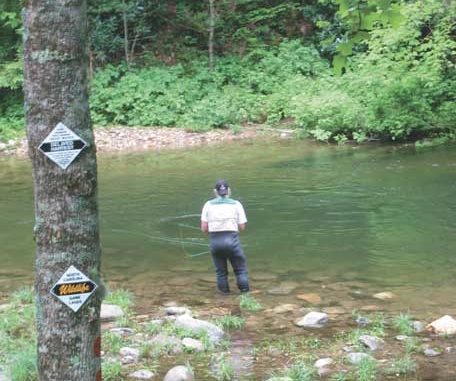
Opening day of the hatchery-supported fishing season will be a bit different this year.
Anglers should see more trout during March, April and May and fewer trout in the hot summer months.
Hatchery-supported waters are closed during March, giving wildlife officials time to stock streams and to give trout time to become acclimated to their new habitats. The 2008-09 season opens 6 a.m., April 5, and Cherokee Tribal waters open March 29, giving anglers two-weekends of prime fishing.
N.C. Wildlife Resources Commission officials are stocking fish differently this year in response to ongoing drought conditions.
Kyle Briggs, WRC hatchery production coordinator, said the goal is to put the majority of the trout in streams when weather and water conditions are more favorable.
He said the compressed stocking schedule won’t affect the numbers or sizes of fish stocked. However, it will reduce the number of fish in fresh-water hatcheries, giving trout a better chance to thrive and survive the anticipated hot, dry weather of late summer.
Last August more than 100,000 brown and rainbow trout died at the Armstrong Hatchery in McDowell County because of elevated water temperatures and lack of rain. Those trout were scheduled to be stocked in 2008. Fortunately, the state’s two other hatcheries produced enough trout to offset the loss.
Without the compressed stocking schedule, “we could lose substantially more fish that we lost in 2007,” Briggs said. “We wouldn’t be able to make up that number of fish from other hatcheries.”
Delayed-harvest waters won’t be affected by the new stocking schedule. Those streams were stocked as usual during October and November when streams reverted to catch-and-release regulations.
What the new stocking schedule amounts to is having plenty of trout this spring, when fishing is at its best.
Opening day of trout season is always a fun event, even if streams are crowded (usually) and the fish aren’t biting (rarely). The weather is warm and pleasant, wild flowers are blooming, nature is awakening from its winter sleep, and everything is fresh and new. What better place to be on a fine spring day than on a mountain trout stream with a fishing rod in your hand?
If you get to a stream early enough, you’re almost guaranteed to catch a mess of trout for supper. Fry some potatoes, mix in a handful or two of fresh ramps, and you’ll have a feast that will be hard to duplicate anywhere.
Opening day at Cherokee usually attracts a large number of anglers because of the excellent fishing. Usually, about 3,000 people turn out opening day to fish the reservation’s
30-plus miles of streams.
Only a tribal permit is required to fish Cherokee Enterprise Waters. Cost is $7 per day, and the limit is 10 fish. There are no bait or lure restrictions and no minimum size limit.
Anglers who prefer to catch and release their fish also must abide by the 10-fish limit.
The state’s hatchery-supported fishing program includes approximately 1,000 miles of streams and several small lakes. Trout for District 9, which covers the state’s 12 westernmost counties, are produced at the Pisgah State Fish Hatchery near Brevard. Trout for District 7 and 8 are produced at the Armstrong Hatchery.
WRC personnel are expected to stock approximately 700,000 trout this season, enough to meet the needs of the delayed-harvest fishing program and the hatchery-supported fishery.
Stockings consist of 40 percent rainbows, 40 percent brook trout, and 20 percent brown trout. These trout usually measure between 8 and 10 inches in length, but the state also stocks a number of trophy-size fish, weighing from 2 to 5 pounds.
Stocked lakes include Powhatan in Buncombe County, Cheoah Reservoir in Graham County, Balsam Lake, Bear Creek Lake, and Tanasee Creek Lake in Jackson County, Queens Creek Lake and Cliffside Lake in Macon County, Max Patch Pond in Madison County and Calderwood Reservoir in Swain County.
Hatchery-supported trout waters are posted with green-and-white signs.
The daily creel limit in hatchery-supported waters is seven trout. There is no size limit, and fishers may use artificial lures or live bait.
Hatchery fish can be caught with a variety of baits and lures. Berkley Power Baits and commercial salmon eggs have become popular with area trout fishers, and they catch as many fish as crickets and worms. Best Power Bait colors for early season and clear water are chartreuse and yellow. If the water is dingy, use fluorescent orange, red or pink.
For spinner fishing, use darker-colored lures in blue, gray and black with gold blades for sunny days and silver blades for cloudy days or fishing dingy water. Popular lures are Rooster Tails, Mepps Aglia, Panther Martin and the Blue Fox Minnow Spins.
The key to catching fish with spinners, veteran fishers say, is experimenting, using different colors and different lures until finding a combination that works.
Trout, even the hatchery-raised kind, can be finicky. A snap swivel attached to the terminal end of monofilament line will make changing lures easier and faster. Swivels also help keep line from twisting.
Lure sizes depend upon the type of water one is fishing. When streams are full, use a 1/8-ounce lure. In smaller streams and in low water conditions, drop to a 1/16th-ounce. For best casting results, use 4-pound-test line for small lures, and nothing larger than 6-pound test for larger lures.
For fishing state-managed trout streams, anglers will need a comprehensive fishing license. Cost is $20 for N.C. residents. Short-term licenses are available for non-residents.
“North Carolina Trout Fishing Maps,” published by the WRC, lists all the state’s designated public mountain trout waters.
Streams are color coded to show the stream’s designation (hatchery-supported, wild, catch-and-release, etc.)




Be the first to comment